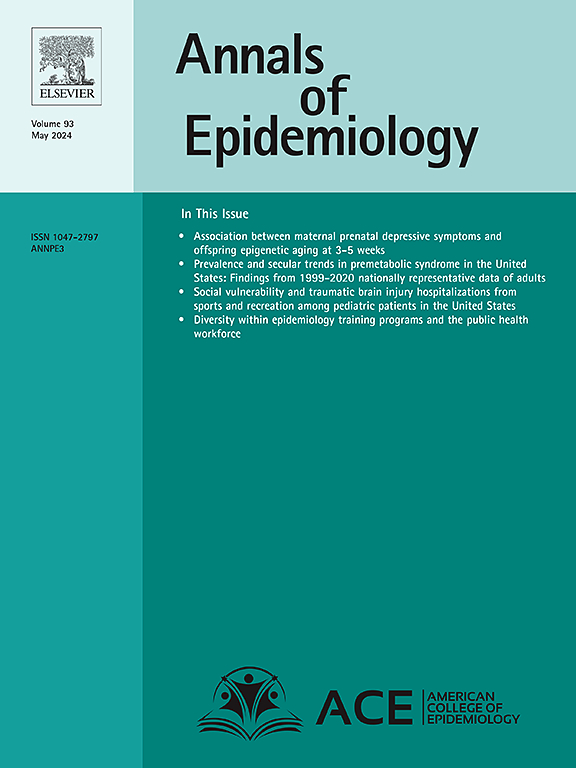2019冠状病毒病早期大流行期间暂停驱逐的持续时间和围产期结局:对2020年3月至5月美国出生婴儿的人口水平分析
IF 3
3区 医学
Q1 PUBLIC, ENVIRONMENTAL & OCCUPATIONAL HEALTH
引用次数: 0
摘要
目的:评估美国2020年3月至4月颁布的州一级暂缓驱逐期限与围产期结局之间的关系。方法:我们使用2020-2021年出生档案的数据来识别在2020年3月至5月怀孕的有医疗补助或没有保险的个体。暴露量是暴露于禁令的月数(0(参考,没有国家级禁令),1-2,3-4,5或更多)。结局包括早产(PTB, < 37孕周)、极早产(VPTB, < 32孕周)、低出生体重(LBW, < 2500克)、极低出生体重(VLBW, < 1500克)、原发性剖宫产或孕产妇发病。我们使用对数二项回归估计风险比(rr),包括个人、县和州一级的混杂因素。我们进行了多项敏感性分析,包括2019年概念的负控制分析和差中差分析,以排除残留的州一级混杂。结果:我们纳入了375,821例新生儿。调整后,与没有暂停的州相比,暂停5个月或更长时间与PTB (RR: 0.95, 95% CI: 0.88, 1.02)、VPTB (RR: 0.90, 95% CI: 0.8-1.01)、LBW (RR: 0.95, 95% CI: 0.9-1.01)和VLBW (RR: 0.91, 95% CI: 0.81-1.02)的风险略有降低相关。与剖宫产或产妇发病率无关联。敏感性分析表明,所有或大部分观察到的关联都可以用残留的状态混淆来解释。结论:州级暂缓驱逐与生育结果的改善有关,但观察到的所有或大部分关联可能是由于其他政策行动或颁布州的特征。本文章由计算机程序翻译,如有差异,请以英文原文为准。
Duration of exposure to eviction moratoria in the early COVID-19 pandemic and perinatal outcomes: A population-level analysis of US births conceived in March-May 2020
Objective
To estimate associations between the length of state-level eviction moratoria enacted in March and April 2020 in the United States and perinatal outcomes.
Methods
We used data from natality files, 2020–2021 to identify individuals with Medicaid or no insurance who conceived in March-May 2020. The exposure was the number of months exposed to a moratorium (0 (referent, no state-level moratoria), 1–2, 3–4, 5 or more). Outcomes included preterm birth (PTB, < 37 weeks gestation), very preterm birth (VPTB, < 32 weeks gestation), low birthweight (LBW, < 2500 g), very low birthweight (VLBW, < 1500 g), primary cesarean, or maternal morbidity. We estimated risk ratios (RRs) using log-binomial regression, including individual, county, and state-level confounders. We conducted several sensitivity analyses to rule out residual state-level confounding including a negative control analysis of 2019 conceptions and difference-in-difference analysis.
Results
We included 375,821 births. Following adjustment, having a moratorium in place for 5 or more months was associated with slightly reduced risk of PTB (RR: 0.95, 95 % CI: 0.88, 1.02), VPTB (RR: 0.90, 95 % CI: 0.8–1.01), LBW (RR: 0.95, 95 % CI: 0.9–1.01), and VLBW (RR: 0.91, 95 % CI: 0.81–1.02) compared to states without a moratorium. There was no association with cesarean or maternal morbidity. Sensitivity analyses showed that all or most of the observed associations may be explained by residual state-level confounding.
Conclusions
State-level eviction moratoria were associated with improved birth outcomes, yet it is likely that all or most of the observed association is due to other policy actions or characteristics of enacting states.
求助全文
通过发布文献求助,成功后即可免费获取论文全文。
去求助
来源期刊

Annals of Epidemiology
医学-公共卫生、环境卫生与职业卫生
CiteScore
7.40
自引率
1.80%
发文量
207
审稿时长
59 days
期刊介绍:
The journal emphasizes the application of epidemiologic methods to issues that affect the distribution and determinants of human illness in diverse contexts. Its primary focus is on chronic and acute conditions of diverse etiologies and of major importance to clinical medicine, public health, and health care delivery.
 求助内容:
求助内容: 应助结果提醒方式:
应助结果提醒方式:


